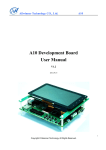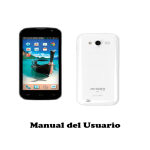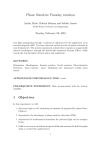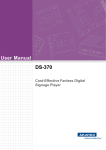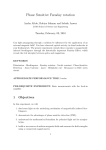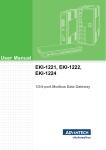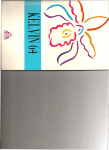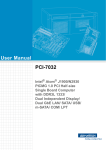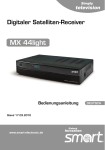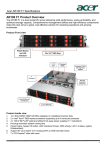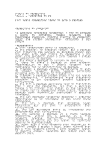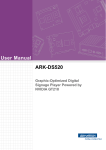Download All Winner Technology CO., Ltd
Transcript
All Winner Technology CO., Ltd A10 development board hardware manual V1.1 August 24, 2011 All Winner Technology CO., Ltd Version History Version number Date Modifications V1.0 2011-6-7 The initial version V1.1 2011-8-24 According to EVB-V12, revise and improve the Remarks All Winner Technology CO., Ltd Table of contents 1A10 Development Board introduction...............................................................................................1 1.1A10 Overview.............................................................................................................................1 1.2Development Board Features......................................................................................................1 1.2.1Super video codec...............................................................................................................1 1.2.2Powerful audio capabilities.................................................................................................1 1.2.3Picture browsing.................................................................................................................1 1.2.4Features full e-book............................................................................................................1 1.2.5Large-capacity storage........................................................................................................1 1.2.6Super-rich peripheral interfaces .........................................................................................1 1.2.7A variety of start-up mode..................................................................................................1 1.2.8A variety of operating systems ...........................................................................................1 1.3Development board configuration..............................................................................................1 1.3.1Standard..............................................................................................................................1 1.3.2Optional ..............................................................................................................................1 1.4Functional block diagram of the development board.................................................................1 1.5Power tree diagram of the development board...........................................................................2 1.6Typical Applications...................................................................................................................2 1.7Documentation ...........................................................................................................................2 1.8Contact........................................................................................................................................2 1.9Chapter II hardware resources....................................................................................................2 1.10Dimensions diagram.................................................................................................................2 1.11Front picture..............................................................................................................................2 1.12Back picture..............................................................................................................................2 1.13Hardware resources...................................................................................................................2 1.14CPU ..........................................................................................................................................2 1.15Power supply.............................................................................................................................2 1.15.1Power input.......................................................................................................................2 1.15.2Power Output....................................................................................................................2 1.15.3PMU .................................................................................................................................2 1.15.4Power LED D2 .................................................................................................................2 1.15.5Charge status and alarm indicator D1 ..............................................................................2 1.15.6Reset button.......................................................................................................................2 1.15.7power soft-switching button .............................................................................................2 1.16DRAM .....................................................................................................................................2 1.17Boot Device .............................................................................................................................2 1.17.1RECOVER Button............................................................................................................2 1.17.2SD/MMC card socket .......................................................................................................2 1.17.3NAND Flash ....................................................................................................................2 1.18TF card socket ..........................................................................................................................2 1.19SDIO WIFI socket ...................................................................................................................2 1.20JTAG Interface.........................................................................................................................2 1.21Ethernet ....................................................................................................................................2 1.22EEPROM .................................................................................................................................2 1.23USB OTG ................................................................................................................................2 1.24USB HOST ..............................................................................................................................2 1.25SATA .......................................................................................................................................2 All Winner Technology CO., Ltd 1.26TV IN .......................................................................................................................................2 1.27CVBS OUT ..............................................................................................................................2 1.28VGA OUT ................................................................................................................................2 1.29TTL LCD .................................................................................................................................2 1.30LVDS LCD interfaces..............................................................................................................2 1.31touch panel interface.................................................................................................................2 1.32HDMI .......................................................................................................................................2 1.33Analog Audio Output................................................................................................................2 1.34Analog Audio Input..................................................................................................................2 1.35Microphone ..............................................................................................................................2 1.36User keys & LRADC................................................................................................................2 1.37Infrared Transceiver Interface..................................................................................................2 1.38UART .......................................................................................................................................2 1.39Camera sensor interfaces..........................................................................................................2 1.40Transport Stream Interface.......................................................................................................2 1.41TWI Interface (Two Wire Interface)........................................................................................2 1.42Gyro Interface...........................................................................................................................2 1.43G-Sensor Interface ...................................................................................................................2 1.44Light Sensor Interface ..............................................................................................................2 1.45 GPS Interface ..........................................................................................................................2 1.46Bluetooth Interface ..................................................................................................................2 1.47External Interrupt (EINT).........................................................................................................2 1.48signal defined expansion header...............................................................................................2 1.48.1IDC socket U11.................................................................................................................2 1.48.2IDC socket U12 ................................................................................................................2 1.48.3IDC socket U27 ................................................................................................................2 1.48.4IDC socket U29 ................................................................................................................2 1.48.5IDC socket U31 ................................................................................................................2 1 A10 Development Board introduction 1.1 A10 Overview A10 uses ARM's Cortex-A8 processor, to build a whole new generation of intelligent network processor SOC HD-A10, which will significantly enhance the level of SOC applications, multimedia consumer electronics products and make the user experience has increased substantially and improve the . A new generation of highly integrated processors will be the leading network video performance and cost-effective features, widely used in tablet PCs, home intelligent HD network players, automotive multimedia controller, network security monitoring, and a variety of portable multimedia entertainment products and other emerging the market. The A10, with technology to further promote the application of high-definition video codec technology, SOC in the next-generation network integrates high-definition H.264 high Profile of 1080P coding techniques. Full high-definition format decoding technology will meet the multichannel decoding applications 1080P View. The A10, with its own high-efficiency technology in the advanced graphics acceleration framework, but also the introduction of ARM's MALI400 2D/3D graphics processor, to more smoothly support the popular operating systems such as intelligent android2.3/3.0 for android product performance and user experience will greatly enhance and improve. All Winner Technology CO., Ltd 1.2 Development Board Features A10 development board is designed specifically for the A10 chips, compact, full-featured, flexible. Primarily for business for the A10, tablet PCs, home intelligent HD network players, automotive multimedia controller, network security monitoring, and a variety of products such as portable multimedia entertainment software and hardware development, debugging platform, or product design information. 1.2.1 Super video codec Support full HD (1920 * 1080P) video decoding, H.264, H.263, VC-1, MPEG-1/2/4, DIVX-3/4/5 / 6, XVID, WMV7 / 8, VP8, VP6 , AVS jizun, supports all major formats and other high-definition video package almost all HD video formats; support for JPEG and H.264 encoding (1080P @ 60fps; 720P @ 100fps) Support H.264 encoding, 1080P @ 60fps, 720P @ 100fps. 1.2.2 Powerful audio capabilities Music player supports all mainstream music, such as MP3, WMA, OGG, FLAC, APE, AAC, ATRA, etc. 1.2.3 Picture browsing Support high-definition JPEG, GIF, BMP formats. Maximum image size supported 16384x16384 (for 4:4:4 color formats) 1.2.4 Features full e-book Support E-book, you can read epub, pdf, fb2, pdb, chm, html, txt and other format e-books; support ANSI / ASCII, UTF-8, UTF16-BE, UTF16-LE, GB2312, EUC-KR, SHIFT -JIS, Windows1250/1251 other encoding formats; support English, Simplified Chinese, French, Italian, Spanish, Dutch, Traditional Chinese, Japanese, Korean and other languages. 1.2.5 Large-capacity storage 256M 32 位 DDR2, 4G NAND memory, expandable to 8G (ECC 64, support for Samsung, Toshiba, Hynix, Microm, Intel and other 5xnm, 4xnm, 3xnm, 2xnm process NAND); 1.2.6 Super-rich peripheral interfaces USB2.0 OTG, USB2.0 HOST, HDMI1.3/1.4, LCD, CVBS-OUT, VGA-OUT, SATA, LINEIN、HEADPHONE、 10/100M Ethernet interface, 2 Camera Sensor Interfaces, SDIO WIFI, GPS、 Gyroscope, Light Sensor, Bluetooth, Compass. 1.2.7 A variety of start-up mode A variety of system startup, including NAND FLASH, SD / MMC card start-up; support USB for flashing. All Winner Technology CO., Ltd 1.2.8 A variety of operating systems Support for the major operating systems, Android 2.3.4, Linux2.6, WinCE6.0. 1.3 Development board configuration 1.3.1 Standard 1. A10 development board 2. USB to serial debug line (USB switch to TTL) 3. 12V @ 2A power adapter 4. 5-inch LCD with touch screen module (TFT 800 * 480 high-definition, four-wire resistive touch screen) A10 Development board USB to serial debug Power adapter cable 并口线 1.3.2 Optional 1. head board camera 2. SDIO WIFI module 3. 7-inch LCD with touch panel module (TFT 800 * 480 high-definition, TTL interface) SDIO WIFI module Camera head board All Winner Technology CO., Ltd 1.4 Functional block diagram of the development board All Winner Technology CO., Ltd 1.5 Power tree diagram of the development board 1.6 Typical Applications • • • Tablet PC Smartphones Smart TV • Video surveillance, traffic recorder, DV and other codec devices. • Smart Playlist box, sound bar, speakers and other home theater. • Games, advertising machines, industrial machines and other interactive devices. All Winner Technology CO., Ltd GPS, car entertainment systems. • 1.7 Documentation • A10 Development Board Hardware User's Manual • A10 Android development board manual • A10 development board Linux Manual • A10 WinCE6.0 development board manual • A10 development board schematics. • A10 Datasheet • AXP209 Datasheet 1.8 Contact Company: Zhuhai Zhi Technology Co., Ltd. all Address: Zhuhai Southern Software Park Building, 4th Floor B6 Tel :0756 -3818315 Fax :0756 -3801678 All Winner Technology CO., Ltd 1.9 Chapter II hardware resources 1.10 Dimensions diagram All Winner Technology CO., Ltd 1.11 Front picture All Winner Technology CO., Ltd 1.12 Back picture 1.13 Hardware resources Name Description CPU Cortex-A8 32KB I-Cashe, 32KB D-Cache and 256KB L2 Cache Trustzone Technology PMU X-Power AXP209 "flash charge core", 1.8A PWM switching charge, intelligent power management controller, can receive 5V power adapter, battery, USB5V power input, to provide 7 power outputs DRAM 4 2Gbit 16 DDR3, total 1024MB DRAM. NAND Flash Hynix H27UBG8T2A, 4G Bytes MLC 64bit ECC NAND Flash, the board can be expanded to two a total of 8G Bytes. Can be used as boot device. TF Card Interface Memory card can support up to 32G. Card detection SD / MMC card interface Support SD / MMC card reader can be used as boot devices. SDIO WIFI card interface For SDIO WIFI card All Winner Technology CO., Ltd Ethernet 10M/100M IEEE802.3, uses chip Realtek RTL8201CP RJ45 connector USB Host 2 USB Host interfaces, can support high-speed (HS, 480-Mbps), full-speed (FS, 12-Mbps), and low-speed (LS, 1.5-Mbps) data transmission USB OTG USB OTG 2.0. Host mode can support high-speed (480-Mbps), full-speed (12-Mbps) and low-speed (1.5-Mbps) data transfer. Device mode can support high-speed (480-Mbps), and full-speed (12-Mbps) data transfer TV-OUT Interface CVBS (commonly known as AV) output VGA-OUT Interface VGA output, maximum support 1920 * 1080 resolution HDMI output HDMI v1.3, up to 1080P @ 50/60fpts LCD Provides one 50pin FPC interface, one LCD screen interface as a 44pin IDC Interface expansion Development, can support a variety of screen sizes: The following CPU 3-inch screen; 3-inch RGB display; 8 inch LVDS panel TouchPanel interface Supports 4-wire resistive touch screen Interface capacitive touch screen and TWI Camera sensor interface Camera sensor offers two sets of interface signals. NTSC and PAL CCIR656 Protocol support 8-bit input data Microphone Supports 2-way MIC input Headphone Stereo headphone output. Line-in 2 audio inputs. TWI Development board provides two sets of TWI interfaces UART Provides one UART interface: TTL level or RS232 level. JTAG JTAG debug interface. Buttons Provides five definable function keys and RESET and POWER_ON keys. Infrared data reception IR supports only infrared data reception. Battery Interface Such as single-cell 4.1V/4.15V/4.2V/4.36V lithium battery, rechargeable. AC adapter connector 12V DC power supply. The third chapter details the hardware This section will describe in detail the various hardware development board A10 module, interface, technical parameters, pin definitions, related configuration, use precautions. All Winner Technology CO., Ltd 1.14 CPU The A10 CPU is a cost effective, high integration, high performance, low-power 16/32-bit multimedia applications processor. The CPU core is a Cortex-A8 with 32KB instruction, 32KB data and 256K L2 caches. The CPU integrates many features to reduce overall system cost and product development effort. Using 441 pin 0.8mm pitch BGA package. Small size, low power, low heat. 1.15 Power supply 1.15.1 Power input Tha A10 board can use any compination of the 12V power adapter, battery os USB power. The PMU will do the smart choice to determine: 1. 12V power adapter, input from the J1 connector, provides up to 2A current. 12V DC power supply through one DCDC chip MP1482D, output 5V @ 2A for the PMU to use, but also for the two USB HOST Interface: USB1, USB2. 2. Battery-powered, input from the J2 connector. Such as single-cell support 4.1V/4.15V/4.2V/4.36V lithium batteries (lithium ion or lithium polymer). The default target battery voltage (Vtrgt) 4.2V, Automatic recharge voltage (Vtrgt-0.1) V. Vtrgt set by PMU registers. 3. USB power input, the input from a P2 USB OTG Interface 5V power supply. USB power socket Battery socket All Winner Technology CO., Ltd 12V power connector 12V power switch 1.15.2 Power Output From the J12 socket output DC 12V, DC 5V, DC 3.3V, GND. For user extensions. Power outlet All Winner Technology CO., Ltd 1.15.3 PMU PMU choices are highly integrated power system management chip AXP209, which integrates an adaptive PWM charger's USB-Compatible, 2 step-down converter (Buck DC-DC Converter), 5 linear regulators (LDO ), voltage / current / temperature multi-channel 12-Bit ADC, and 4-way configurable GPIO. In order to ensure power system security and stability, AXP209 also incorporates over / under voltage (OVP / UVP), over temperature (OTP), overcurrent (OCP) and other protective circuits. AXP209 provides a two-wire serial communication interface: Two Wire Interface (TWI), the application processor can use this interface to turn on or off certain power output, the voltage set them to access the internal registers and a variety of measurement data (including Fuel Gauge). High accuracy (1%, mainly by the 1% precision resistors BIAS decision) to facilitate measurement of electricity consumers to grasp more clearly the real-time energy usage. AXP209 intelligent energy balance (Intelligent Power Select, IPSTM) circuit in the USB, and external AC adapter, battery and load application transparent distribution of power between the safety and the only external input power without the battery (or battery discharge / damage) in the case also allows applications to work properly. The specific energy distribution as follows: • When the only access to lithium batteries, no external power input (VBUS or ACIN), the use of lithium-powered; • When an external supply (VBUS or ACIN), preferred to use an external power supply; • The case of the battery connection, external power supply is removed, immediately "seamless" switches to battery power supply; All Winner Technology CO., Ltd • When VBUS and ACIN both access, the priority ACIN power, and to charge the lithium battery; • If not enough ACIN drive capability, it will open the VBUS timely access, to achieve ACIN / VBUS common power supply; • If the drive capacity is still insufficient, it will reduce the charge current up to 0, then added with the battery power supply; AXP209 1.15.4 Power LED D2 PMU works, the power light is light D2; otherwise off the power indicator D2. Power LED D2 All Winner Technology CO., Ltd 1.15.5 Charge status and alarm indicator D1 D1 indicates charging status indicator and alarm, which indicates that four states: charging, not charging, battery and external power supply abnormal overvoltage alarm alarm. As follows: LED status Note Steady Charging Off Not charging Flashes at 1Hz Battery usage or the charge level into the battery is too low Flashes at 4Hz frequency PMU input voltage is too high Charge status and alarm indicator All Winner Technology CO., Ltd 1.15.6 Reset button Development board provides a reset button, the development board can be reset. Reset button All Winner Technology CO., Ltd 1.15.7 power soft-switching button Development board provides a soft power switch button, connected to the PMU POWON signal. By default, press (6 seconds) to achieve the power output of all PMU (RTC power LDO1 excluded) of the switch. PMU can identify this button "press" and "Press" and send to the CPU IRQ, so users can customize the "long press" and "press" the button application. Specifically refer to the AXP209 Datesheet. Soft power switch button All Winner Technology CO., Ltd 1.16 DRAM Use the four 2G Bit 16 位 DDR3, constitute 32 1024M Bytes DRAM. Ensure the system's highspeed operation. Frontal two 2GBit DDR3 All Winner Technology CO., Ltd The back two 2GBit DDR3 1.17 Boot Device 1.17.1 RECOVER Button A10 development board provides the RECOVER button, the system can be used to select or start a key upgrade. All Winner Technology CO., Ltd A10 and it can support multiple device boot, when the system power or reset button is pressed first check RECOVER, if RECOVER button not pressed, the system first from the SD / MMC card (U26) to boot the system, failed to guide from the NAND Flash system, NAND Flash boot failure from USB0 download firmware. If you hold down the RECOVER button, the system skips all the boot device, download the firmware from USB0. RECOVER Button 1.17.2 SD/MMC card socket Development board provides an SD / MMC card interface, the SD CARD0 using the A10 interface. Its characteristics are as follows: • Support SD / MMC card reader. Compatible with Secure Digital memory (up to SD3.0), Secure Digital I / O, Multimedia Card (up to MMC4.3). • Memory card can support up to 32G. • Provide 3.3V voltage, providing card detection (interrupt IO). SD / MMC card socket (Card0) All Winner Technology CO., Ltd 1.17.3 NAND Flash Development board equipped with a Hynix H27UBG8T2ATB, 4G Bytes MLC 64bit ECC NAND Flash. Use the four CE signal and 2 RB signal. Board also set aside a NAND Flash location. Supports up to two single or two pairs of selected chip select NAND. Maximum capacity to support 16G. 4G NAND Flash All Winner Technology CO., Ltd Location reserved for NAND Flash All Winner Technology CO., Ltd 1.18 TF card socket Development board provides an interface to TF card, the SD CARD1 using the A10 interface. Its characteristics are as follows: • Support TF card reader, compatible with Secure Digital memory (up to SD3.0). • Memory card can support up to 32G. • Provide 3.3V voltage, providing card detection (interrupt IO). TF card socket (Card1) 1.19 SDIO WIFI socket Development board provides an SDIO WIFI card interface, the SD CARD3 using the A10 interface. Its characteristics are as follows: • Developed primarily for SDIO WIFI card use. Support SDIO 1-bit and 4-bit interrupt mode; support suspend and resume operation; support read wait. • Also available for SD / MMC card. Compatible with Secure Digital memory (up to SD3.0), Secure Digital I / O, Multimedia Card (up to MMC4.3). • Memory card can support up to 32G. • Provide 3.3V voltage, providing card detection (interrupt IO). SDIO WIFI socket (Card3) All Winner Technology CO., Ltd 1.20 JTAG Interface Standard JTAG debug interface offers 14pin 2.0mm IDC socket. User via the JTAG debug the system. JTAG Interface All Winner Technology CO., Ltd 1.21 Ethernet evelopment board provides network functionality, network interface chip REALTEK RTL8201CP chip. Its characteristics are as follows: • Interface uses a Link / Active LED and isolation transformer RJ45 socket. • Compatible with IEEE802.3 standards, support full and half duplex operation. • Support 10/100M data rate. Network interface chip Ethernet RJ45 socket All Winner Technology CO., Ltd 1.22 EEPROM Onboard a 2 Mbytes EEPROM AT24C16B, using the system TWI1 interface communication. MAC address can be used as storage or other applications. 2M Bytes EEPROM 1.23 USB OTG Development board provides a USB OTG interface, use the A10 USB0 interface. Its characteristics All Winner Technology CO., Ltd are as follows: • Fully compatible with USB OTG 2.0 specification. • Can be configured as stand-alone USB HOST or USB DEVICE, fully compatible with USB 2.0 specification. • Host mode can support high-speed (480-Mbps), full-speed (12-Mbps) and low-speed (1.5Mbps) data transfer. • Device mode can support high-speed (480-Mbps) and full-speed (12-Mbps) data transfer. • Can detect VBUS insert, ID signal. • Can enable the VBUS output, VBUS output current limiting 1A. • Using a standard MINI-USB socket. Socket number Interface signals VBUS output enable P2 DM0/DP0(USB0) GPIOB9 USB OTG (USB0) VBUS detection ID detection GPIOH5 GPIOH4 1.24 USB HOST Development board provides two USB HOST interfaces, respectively, using the A10 interface to the USB1 and USB2 interface. Its characteristics are as follows: • Fully compatible with USB 2.0 specification. • Able to support high-speed (480-Mbps), full-speed (12-Mbps) and low-speed (1.5-Mbps) All Winner Technology CO., Ltd data transfer. • Supplies VBUS output enable, respectively. • Using a standard USB Type A socket. Socket number Interface signals VBUS output enable P3 DM1/DP1(USB1) GPIOH6 P4 USB HOST (USB1) DM2/DP2(USB2) GPIOH3 USB HOST (USB2) 1.25 SATA Development board to provide a SATA interface. Its characteristics are as follows: • Supports SATA 1.5Gb/s, and SATA 3.0Gb/s • Compliant with SATA Spec. 2.6, and AHCI Revision 1.3 Specifications • Supports industry-standard AMBA High-Performance Bus (AHB) and it is fully compliant with the AMBA Specification, Revision 2.0. Supports 32-bit Little Endian • OOB signaling detection and generation • SATA 1.5Gb/s and SATA 3.0Gb/s speed negotiation when Tx OON signaling is selected • Supports device hot-plugging • Support power management features including automatic Partial to Slumber transition All Winner Technology CO., Ltd • Internal DMA Engine for Command and Data Transactions • Supports hardware-assisted Native Command Queuing (NCQ) for up to 32-entries • Support external SATA (eSATA) SATA connector 1.26 TV IN Provides 3-way video input, support CCIR-656 4:2:2 8-bit parallel input format. Using Cinch. 1.27 CVBS OUT Video CVBS output to provide a way to support 4 X12-bit DAC output data. Using Lotus jack for connecting TV and other equipment. CVBS output socket All Winner Technology CO., Ltd 1.28 VGA OUT VGA output support RGB. Support for 4 X12-bit DAC output data. Using DB15 socket, can be directly output to the computer monitor. Easy to use monitor for video development. VGA output socket All Winner Technology CO., Ltd 1.29 TTL LCD A10 LCD controller has the following features: • Support the HV-DE-Sync (digital parallel RGB) input LCD panels (Max 1024 * 1024 resolution ,24-bit color). • Support the HV-DE-Sync (digital serial RGB, both delta and stripe panel) input LCD panels (Max 680 * 1024 resolution, up to true color). • Support TTL (digital RGB) input LCD panels (Max 1024 * 1024 resolution, 18-bit color). • Support Analog RGB input LCD panels (Max 1024 * 1024 resolution, 3 channel 6bit DAC output). • Support 18/16/9/8bit 8080 CPU I / F panels (Max 1024 * 1024 resolution). • CCIR-656 output interface. Onboard a 50pin FPC socket and plugs directly into supporting the 5-inch 800 * 480 high-definition LCD touch screen, or other TTL LCD support for development. While providing a 44pin 2.0mm IDC expansion socket outlet as the LCD for users to develop other dimensions of LCD applications. Provide three GPIO Using as LCD control, a PWM as the backlight control. 3.3V and 5V power output. 3.3V power supply controlled by the GPIO off. 50pin LCD FPC 44pin 2.0mm LCD All Winner Technology CO., Ltd 1.30 LVDS LCD interfaces Provides four LVDS outputs: 3 sets of data signals and a set of clock signals. Provide three GPIO as LCD control, a PWM as backlight control. 3.3V and 5V power output. 3.3V power supply controlled by the GPIO off. Provide four-wire resistive touch screen interface signals. Using a 44pin 2.0mm IDC connector. Can insert the optional LVDS LCD module development. Note: • FPC connector J9, IDC sockets U7, IDC socket U8 multiplexing a signal, at the same time can only use one interface. • VGA and TTL LCD common signal HSYNC and VSYNC, VGA and TTL LCD can not be used. 44pin 2.0mm LVDS LCD IDC All Winner Technology CO., Ltd 1.31 touch panel interface A10 Touch Panel ADC has the following features: • Support interrupts. • 11-bit resolution. • Input voltage range: 0V to 2/3AVCC (2.0V). • Sampling rates up to 128K. • Support the four-wire resistive touch screen. TWI interface development board Able to support capacitive touch screen, Using the A10 TWI2 interface signals. provides a 4pin FPC, users can TTL LCD IDC or LVDS LCD IDC expansion capacitive touch screen interface. 4pin FPC capacitive panel interface All Winner Technology CO., Ltd 1.32 HDMI A10 built-in HDMI interface, has the following features: • HDMI V1.3 compliance • Support Max 4K*4K resolution • Support up to 165M pixel/second • Support 480I/576I/480P/576P/720P/1080I/1080P at 24/25/30/50/50.9Hz • Support 24/30/36/48-bit RGB data format,with 2X/4X repeater • Support up to 8 channel,24bit PCM • Support IEC61937 compress audio formats • Support 1-bit audio • Support HD audio • Hardware Receiver active sense and Hot plug detect • Interrupts for programmer HDMI socket All Winner Technology CO., Ltd 1.33 Analog Audio Output Development board provides two analog audio output with 3.5mm stereo headphone jack. Using DC coupling. Audio output jack All Winner Technology CO., Ltd 1.34 Analog Audio Input Development board provides two analog audio inputs, 3.5mm stereo headphone jack. AC coupling. 24-bit DAC。 Support for 48K and 44.1K sampling rate Support for 192K and 92K sampling. Audio input jack All Winner Technology CO., Ltd 1.35 Microphone Onboard two-way Microphone, stereo recording can be done the development. 24-bit DAC。 Support for 48K and 44.1K sampling rate Support for 192K and 92K sampling. Left Mic All Winner Technology CO., Ltd Right Mic All Winner Technology CO., Ltd 1.36 User keys & LRADC A10 provides a two-way Low Resolution ADC input (LRADC0, LRADC1), as a key application. Its characteristics are as follows: • Support interrupts. • 6-bit resolution. • Voltage input range 0 to 0.67 * AVCC (AVCC is LRADC reference voltage). • Sampling rates up to 250HZ. LRADC0 is connected to the development board, predefined commonly used for the ANDRIOD's seven buttons: VOL +, VOL-, MENU, SEARCH, HOME, ESC, ENTER. Users can also customize the button functions. A10 also provides RECOVER button can be used as a key boot options or upgrades. See Boot Device. LRADC1 for user extensions. IDC socket for the user in the form of expansion and development to define the signal socket see "expansion connector signal definitions." 1.37 Infrared Transceiver Interface A10 were provided along the way IR-RX and IR-TX. Its characteristics are as follows: • Compatible with MIR FIR IrDA 1.1. • Supports 0.576 Mbit / s and 1.152 Mbit / s Medium Infrared (MIR). • Supports 4 Mbit / s FIR IrDA 1.4. All Winner Technology CO., Ltd • Support CIR remote control or wireless keyboard. IR-RX is connected to the onboard infrared receiver, remote control receiver can be applied directly to do. IR-TX for user extensions. IDC socket to form for users to expand the development, definition of socket signals see "expansion socket signal definition"。 Infrared receiver 1.38 UART Development board provides one UART interface: UART0. Is the standard UART0 RX, TX two-wire serial interface, debug printing as the default interface, the default baud rate is 115200. UART0 supports TTL-level output can be connected to serial port supporting USB (TTL) lines, such as user-friendly notebook PC without RS232 port for debugging print. UART0 also supports RS232 level output. RS232 level output port Using DB9 female socket. RS232 DB9 UART0 TTL UART0 All Winner Technology CO., Ltd 1.39 Camera sensor interfaces Camera sensor development board provides two sets of interface signals. Its characteristics are as follows: • NTSC and PAL CCIR656 agreement. • Supports 8-bit input data. • TWI signal and provides a set of two GPIO signals for controlling the camera to use. • Provides 2.8V and 5V power supply. IDC socket to form for users to expand the development, definition of socket signals see "expansion socket signal definitions." 1.40 Transport Stream Interface A10 Transport Stream controller has the following features: • One external Synchronous Parallel Interface (SPI) or one external Synchronous Serial Interface (SSI)。 • 32 channels PID filter • Multiple transport stream packet (188, 192, 204) format support • SPI and SSI timing parameters are configurable • Hardware packet synchronous byte error detecting All Winner Technology CO., Ltd • Hardware PCR packet detecting • Configurable SPI transport stream generator for streams in DRAM memory • DMA is supported for transferring data • Interrupt is supported • Support DVB-CSA V1.1 Descrambler Development board offers two TS signal for the Mobile TV use. IDC socket to form for users to expand the development, definition of socket signals see "expansion socket signal definitions." 1.41 TWI Interface (Two Wire Interface) A10 TWI interface has the following characteristics: • Software-programmable for Slave or Master • Supports Repeated START signal • Multi-master systems supported • Allows 10-bit addressing with 2-Wire bus • Performs arbitration and clock synchronization • Own address and General Call address detection • Interrupt on address detection • Supports speeds up to 400Kbits/s (‘fast mode’) • Allows operation from a wide range of input clock frequencies Development board provides two interfaces for users to extend the use of TWI. IDC socket to form for users to expand the development, definition of socket signals see "expansion socket signal definitions." 1.42 Gyro Interface IDC socket to form for users to expand the development, definition of socket signals see "expansion socket signal definitions." 1.43 G-Sensor Interface IDC socket to form for users to expand the development, definition of socket signals see "expansion socket signal definitions." 1.44 Light Sensor Interface IDC socket to form for users to expand the development, definition of socket signals see "expansion socket signal definitions." All Winner Technology CO., Ltd 1.45 GPS Interface IDC socket to form for users to expand the development, definition of socket signals see "expansion socket signal definitions." 1.46 Bluetooth Interface IDC socket to form for users to expand the development, definition of socket signals see "expansion socket signal definitions." 1.47 External Interrupt (EINT) A10 provides up to 32 external interrupts. Development board will be one of the 20 external interrupts to IDC socket for the user to extend the form of development, definition of socket signals see "expansion connector signal definitions." 1.48 signal defined expansion header Development board provides five 2.0mm IDC-20 socket for expansion capabilities. Users can use our complementary capabilities to extend sub-board functional development, or design their own sub-board for extensions development. This section will describe the form of a list of the PIN of the expansion header pin signal definitions and functions. Caution is as follows: • The same PIN can only be used at the same time the same function. • Recommend using the recommended function, there will be a better software support, thus reducing development effort and workload. • The default state is GPIO GPIO input, if used for output, then the external pull-up resistor on the circuit or a pull-down resistor. Required to determine the polarity of the signal is to spend or pull-down resistors. All Winner Technology CO., Ltd 1.48.1 IDC socket U11 Socket PIN number U11 Function 1 Function 2 (recommended) Function 3 Function 4 GPIO Camera Sensor 0 Transport Stream 0 External interrupt 1 VCC-5V VCC-5V VCC-5V VCC-5V 2 GPIOH16 CSI0-PWR 3 EINT16 CSI-IO-2.8V 4 GPIOH13 CSI0-RST# EINT13 5 GPIOE0 CSI0-PCK 6 GPIOB18 TWI1-SCK 7 GPIOB19 TWI1-SDA 8 GPIOE3 CSI0_VSYNC TS0_DVLD 9 GPIOE2 CSI0_HSYNC TS0_SYNC 10 GPIOE1 CSI0_CK TS0_ERR TS0-CLK All Winner Technology CO., Ltd 11 GPIOE4 CSI0_D0 TS0_D0 12 GPIOE5 CSI0_D1 TS0_D1 13 GPIOE6 CSI0_D2 TS0_D2 14 GPIOE7 CSI0_D3 TS0_D3 15 GPIOE8 CSI0_D4 TS0_D4 16 GPIOE9 CSI0_D5 TS0_D5 17 GPIOE10 CSI0_D6 TS0_D6 18 GPIOE11 CSI0_D7 TS0_D7 19 GND GND GND GND 20 GND GND GND GND 1.48.2 IDC socket U12 Socket PIN number U12 Function 1 Function 2 Function 3 Function 4 (recommend ed) Function 5 Function 6 GPIO Camera Sensor 1 Transport Stream 1 SD Card 1 UART3/4 External interrupt 1 VCC-5V VCC-5V VCC-5V VCC-5V VCC-5V VCC-5V 2 GPIOH17 CSI1-PWR 3 EINT17 CSI-IO-2.8V 4 GPIOH14 CSI1-RST# 5 GPIOG0 6 GPIOB18 TWI1-SCK 7 GPIOB19 TWI1-SDA 8 GPIOG3 9 CSI1-PCK EINT14 TS1-CLK SDC1_CMD CSI1_VSY NC TS1_DVL D SDC1_D1 GPIOG2 CSI1_HSY NC TS1_SYN C SDC1_D0 10 GPIOG1 CSI1_CK TS1_ERR SDC1_CLK 11 GPIOG4 CSI1_D0 TS1_D0 SDC1_D2 12 GPIOG5 CSI1_D1 TS1_D1 SDC1_D3 13 GPIOG6 CSI1_D2 TS1_D2 UART3_TX 14 GPIOG7 CSI1_D3 TS1_D3 UART3_RX 15 GPIOG8 CSI1_D4 TS1_D4 UART3_RTS All Winner Technology CO., Ltd 16 GPIOG9 CSI1_D5 TS1_D5 UART3_CTS 17 GPIOG10 CSI1_D6 TS1_D6 UART4_TX 18 GPIOG11 CSI1_D7 TS1_D7 UART4_RX 19 GND GND GND GND GND GND 20 GND GND GND GND GND GND 1.48.3 IDC socket U27 Socket U27 PIN number Function 1 Function 2 (recommended) Function 3 Function 4 GPIO WIFI/PA/LS/GS/CP/TWI1/GY IR0 External interrupt 1 VCC-5V VCC-5V VCC-5V VCC-5V 2 GPIOH9 WIFI-SHDN# (SDIO WIFI standby control) 3 VCC-3.3V VCC-3.3V 4 GPIOH12 5 GPIOI3 6 EINT9 VCC-3.3V VCC-3.3V WIFI-PWR (SDIO WIFI power control) EINT12 GPIOH10 WIFI-WAKEUP (SDIO WIFI wakeup) EINT10 8 GPIOH15 PA-SHDN# (Audio PA shutdown control signal) EINT15 9 GPIOH20 LS-INT (Light sensor interrupt input) EINT20 10 GPIOH0 GS-INT1 (External G-sensor interrupt input signal) EINT0 11 GPIOB3 CP-RST# (Compass reset signal) 12 GPIOI13 CP-INT (Compass interrupt input) 13 GND GND GND GND 14 GND GND GND GND 15 GPIOB18 TWI1-SCK 16 GPIOB19 TWI1-SDA 17 GPIOH18 GY-INT1 (Gyroscope interrupt input) EINT18 18 GPIOH19 GY-INT2 EINT19 7 IR0-TX EITN25 All Winner Technology CO., Ltd (Gyroscope interrupt input) 19 GND GND GND GND 20 GND GND GND GND 1.48.4 IDC socket U29 Socket U29 PIN number Function 1 Function 2 (recommended) Function 3 Function 4 GPIO GPS/TWI1/LRADC1/TP PS2-1 External interrupt 1 VCC-5V VCC-5V VCC-5V VCC-5V 2 GPIOI0 GPS-CLK (GPS clock signal) 3 VCC-3.3V VCC-3.3V 4 GPIOI1 GPS-SIGN (GPS data0) 5 GPIOI14 GPS-OSC-EN (GPS clock control) 6 GPIOI2 GPS-MAG (GPS data1) 7 GPIOC22 GPS-VCC-EN (GPS power control) 8 GPIOC19 GPS-SCS (GPS SPI chip select) 9 GPIOI15 GPS-RX-EN (GPS RX enable) 10 GPIOC20 GPS-SCLK (GPS SPI serial clock) 11 VCC-3.3V VCC-3.3V PS2-SCK1 EINT26 PS2-SDA1 EINT27 LRADC1 (Low Resolution ADC input) 12 GPIOC21 GPS-MOSI (GPS SPI data output) 13 GND GND GND GND 14 GND GND GND GND 15 GPIOB20 TWI2-SCK 16 GPIOB21 TWI2-SDA 17 GPIOH21 TP-INT (External TP interrupt input) 18 GPIOB13 TP-WAKEUP (External TP wake up) EINT21 All Winner Technology CO., Ltd 19 GND GND GND GND 20 GND GND GND GND 1.48.5 IDC socket U31 Socket PIN number U31 Function 1 Function 2 (recommended) Function 3 Function 4 Function 5 GPIO Bluetooth UART2 PS2-0 External interrupt 1 VCC-5V VCC-5V VCC-5V VCC-5V VCC-5V 2 GPIOB5 BT-RST# (Bluetooth reset) 3 VCC-3.3V VCC-3.3V VCC-3.3V VCC-3.3V VCC-3.3V 4 GPIOB6 BT-PCM-CLK (Bluetooth PCM clock signal) 5 GPIOB12 BT-PCM-IN (Bluetooth PCM data input) 6 GPIOB7 BT-PCM-SYNC (Bluetooth PCM sync) 7 GPIOI16 BT-UART-RTS (Bluetooth UART RTS) 8 GPIOB8 BT-PCM-OUT (Bluetooth PCM data out) 9 GPIOI18 10 UART2-RTS EINT28 BT-UART-TX (Bluetooth UART TX) UART2-TX EINT30 GPIOI17 BT-UART-CTS (Bluetooth UART CTS) UART2-CTS EINT29 11 GPIOI20 BT-GPIO0 (Bluetooth GPIO) 12 GPIOI19 BT-UART-RX (Bluetooth UART RX) UART2-RX 13 GND GND GND PS2-SCK0 EINT31 GND GND All Winner Technology CO., Ltd 14 GND GND GND GND GND 15 GPIOI21 BT-GPIO1 (Bluetooth GPIO) 16 GPIOI12 17 GPIOI10 18 GPIOI11 19 GND GND GND GND GND 20 GND GND GND GND GND PS2-SDA0 GS-INT2




















































